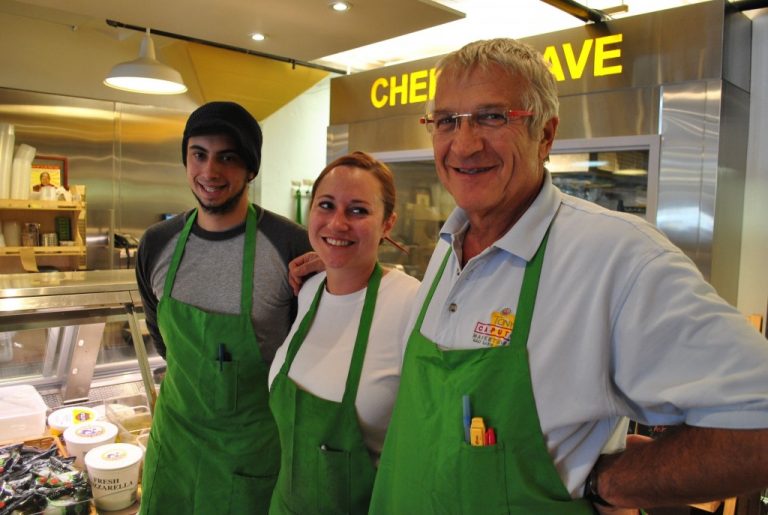
A quartet of Utah’s culinary pioneers
It occurred to me just a week or so ago that I’ve had the privilege of writing about food and drink in Utah for a little over 25 years.
When I first began reviewing restaurants for a tiny publication called the Private Eye in the spring of 1994, I wouldn’t have bet that I’d last 25 months as a restaurant critic, never mind 25 years!
During that time I’ve seen a lot of changes in the Utah dining scene, especially in Salt Lake City and Park City.
Sadly, I’ve watched too many favorite restaurants come and go. I still miss now-defunct eateries like Bill & Nada’s, The Metropolitan, Campagne in Park City, Globe By Moonlight, Le Parisien, the Santa Fe, Capitol Cafe, Cafe Bacchus, and even the short-lived chile parlor in Sandy: Elvis Nixon’s Chili Palace.
But we seem to be in a boom period for new and interesting restaurants. We appear to be in a culinary Golden Age—something that could have only happened thanks to the pioneering spirit and tenaciousness of a few folks that paved the way for all the great food we currently have at arm’s reach.
Here are four culinary pioneers that have helped shaped Utah’s food scene:
Tony Caputo
I first met Tony Caputo when he was working for the late Sam Granato at Granto’s Italian deli and market.
Tony would leave Granato’s and open Caputo’s Market & Deli on 300 South across from Pioneer Park in 1997. I was thrilled for him.
In the 20-plus years since Tony opened Caputo’s, the original store—and all the offshoots it spawned—have become well-travelled outposts for Utah foodies and those who visit here.
He introduced many to imported olive oils, exquisite deli meats and cheeses, highest-quality pastas, a world of artisan chocolates, and much more.
Tony’s son Matt now runs Caputo’s, and Tony is happily semi-retired. I say “semi” because I still run into him frequently at the downtown Caputo’s; maybe he just can’t stay away.
Or, you can often find Tony on Saturdays at the Farmers Market across the street from his original Market & Deli, dispensing wit, wisdom, and bad jokes with a gaggle of old friends. You’ll find them seated behind a table under a banner that reads: “OLD COOTS GIVING ADVICE: It’s probably bad advice, but it’s free.”
Bill White
There are few places—maybe Paris, NYC, and San Francisco—that offer as much fine dining per square block as does Park City.
And that, in my opinion, is due in large part to the effect that restaurateur Bill White has had on that once sleepy ski town.
In 1993, Bill White opened Grappa a the top of Park City’s Main Street—an eye-popping restaurant with sprawling outdoor decks and food that lives up to the views, decor, and scenery.
Grappa raised the dining bar in Park City.
That restaurant was followed by White’s Chimayo and then Wahso—two very different restaurants that share certain traits such as gorgeous decor and ambiance paired with superb food and service.
The Bill White empire now also includes Windy Ridge Cafe & Bakery, Ghidotti’s, Sushi Blue, Billy Blanco’s and most recently, a project he’s put mountains of energy (and money) into: Bill White Farms & Ranch.
I’ve only met a handful of restaurateurs who come anywhere close to Bill White in terms of their quest for excellence. We are lucky he decided to invest his energy and talent in Utah.
Peggi Ince-whiting
You cannot swing a tomcat by the tail these days without hitting a sushi restaurant. They seem to multiply like rabbits.
But that wasn’t always the case.
And, I doubt the sushi scene here in Utah would be so vibrant if not for Peggi Ince-Whiting, who currently serves as Head Sushi Chef at Kyoto Japanese Restaurant.
I first encountered Peggi when I lived in Park City and signed up for her famous Sushi Burn-Off competition, which was held at her Ichiban restaurant on Main Street in Park City. My mouth still burns just thinking about that.
Having been trained by Japanese Sushi Master Inou at Tokyo’s Hama Sushi, Peggi returned to Utah to bring her sushi skills and sensibilities to our then-fledgling dining scene.
When Peggi learned to make sushi, it was rare for women to do so. Now, it’s commonplace. We can thank Peggi Ince-Whiting for both paving the way for sushi-making women and for helping to promote top-quality sushi in our state.
Tom Sieg and John Williams—Gastronomy, Inc.
These days, finding fresh seafood in restaurants—and even in local markets—isn’t a big deal. We take it for granted. But it wasn’t always so.
We have the founders of Gastronomy, Inc.—the company that operates Market Street Grill and Oyster Bar—for introducing Utahns to truly fresh fish.
Gastronomy, Inc. founders Tom Sieg and John Williams (both now deceased) opened The New Yorker restaurant in 1978, and a couple years later brought California restaurateur Tom Guinney in as a partner to launch the Market Street Broiler near the U of U. At the time, fresh fish was typically only available to restaurateurs and chefs living on the coasts, but Gastronomy, Inc. changed that.
Striking a deal with Western Airlines, and later, Delta, to fly fresh seafood daily to Utah meant that Utah diners could expect the freshest seafood—from oysters on the half-shell to Alaskan halibut—to land on their plates at Gastronomy restaurants like Market Street, Baci Trattoria and The New Yorker.
In addition to a commitment to freshness, Gastronomy, Inc. also set new standards in service, with an employee training program and hiring system that many restaurants envy today.
It’s still one of the few places here where I trust the oysters to be as fresh as can be, properly shucked, and served with refreshing professionalism.
To read more of Ted Scheffler’s thoughtful writing, click HERE.





